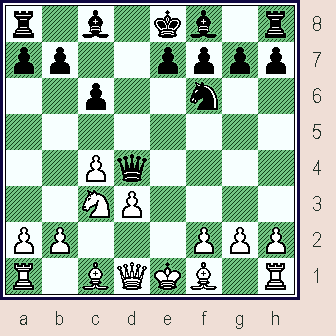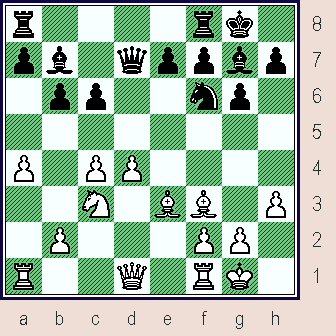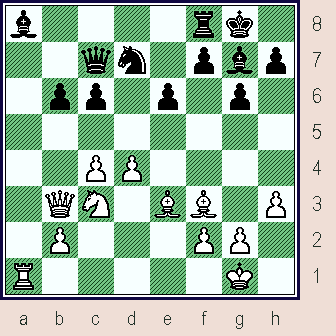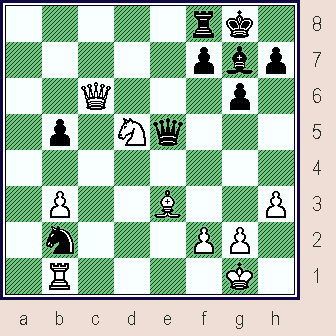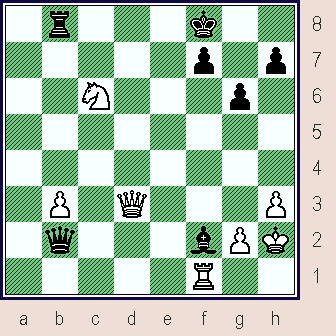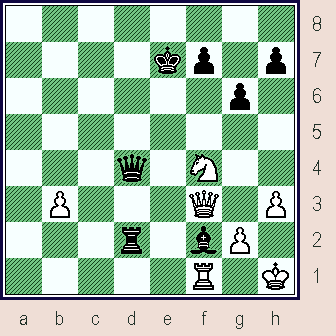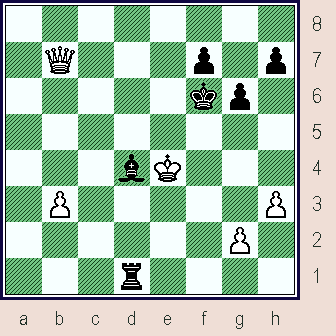All
the |
(Navigation bar
directly below.)
*******
© A.J. Goldsby, 2015.
(All rights reserved.)
****************
Click HERE
to see my
Chess Items.
****************
****************
Buy a book
from Amazon.com
(And help me out as well!)
****************
Click HERE
...
to see a list of the businesses that help to sponsor all of
my chess efforts.
|
|
|
I have spent many months working on the games of Alekhine. I am working on an article/tribute to Alekhine, and this is part of the necessary background work that goes into such an effort. (I have studied over 100 games during this period.) I wanted to find one of Alekhine's best games. I just did not want to find a game that everyone had seen before. I did not want to choose a game that some other author had done ... and simply copy his annotations. I did not want to drool or ooze, and I wanted to be as objective as humanly possible. I found this game in a book on Alekhine ... and after nearly six months of work, I decided that this game ... came as close as possible ... to the criteria, outlined just above. ---> Enjoy! |
Click
HERE
to see an explanation of the symbols that I use when annotating a chess game.
[Replay this game,
but on a different website. You can also download this game in PGN format.]
GM Alexander Alekhine
(2765) -
GM Max Euwe
(2740)
|
|
|
[A.J. Goldsby I]
Perhaps one of Alekhine's most brilliant games, it is often mentioned by many authors ...
Alekhine shows a combinational path in a position that extremely few players would have found.
*** *** *** *** *** *** *** *** *** *** *** *** *** *** *** *** *** *** *** *** *** *** *** *** ***
Alekhine begins with a Reti Opening, showing that he both understood and embraced the (then) new ideas of the hyper-modern movement.
1.Nf3 d5; 2.c4 d4!?;
Black avoids the consequences of the tension on d5 and pushes the foot-soldier bravely forward.
(At the cost of a tempo.)
While this might lead to several possible openings - with colors switched - this might not be the
best approach for Black.
[
Perhaps Black should have tried the following continuation here:
(>/=) 2...c6;
3.b3 Nf6; 4.g3 Bg4; 5.Bg2 e6; 6.0-0
Nbd7; 7.Bb2 Bd6;
8.d3
0-0; 9.Nbd2 Qe7; 10.a3 a5; 11.Qc2, "+/="
{Diagram?}
with just a slight edge for White.
A relatively recent contest is:
B. Cafferty - M. Devereaux; 4NCL 2005-06 / Birmingham,
ENG; (8) / 2006.
{Black won this game, but; (a) He was much higher-rated, and (b) the opening
was hardly the reason for White's loss.}
[ See MCO-14, beginning on page # 704 ... for more details on this vibrant opening. ] ]
3.e3 Nc6; ('!?')
Black develops simply, (I would have preferred to protect the d4-square with a Pawn.).
[ After the following moves:
3...c5!; 4.exd4 cxd4; 5.d3
Nc6; 6.g3 e5; 7.Bg2, "/\"
we have reached a position ... that would be a reversed Benoni.
]
Now Black attempts to give White a backward Pawn. (It fails, as Black is mainly using just the Queen.)
4.exd4 Nxd4; 5.Nxd4 Qxd4; 6.Nc3 Nf6; 7.d3 c6!?;
This prevents any Nb5 by White.
|
|
r1b1kb1r/pp2pppp/2p2n2/8/2Pq4/2NP4/PP3PPP/R1BQKB1R w
This is OK for Black, but the direct 7...e5! might have been a fuzz better. (Alekhine called this a "serious loss of time," however, its not really all that bad.)
[ After the moves: </=
7...Ng4!?; 8.Qe2 Bf5?!; 9.Nb5!
Qd7; 10.f3 Nf6; 11.Qe5, '±'
White wins at least a Pawn.
]
8.Be3 Qd7!?;
(>/= 8...Qd6)
The authors of a relatively recent book on Alekhine, <<A. Alekhine, Master of
Attack>> by Alexander Raetsky and Maxim Chetverik, (AR & MC) question this, however, it looks OK to me.
9.d4 g6;
10.Be2 Bg7;
11.h3!? 0-0; 12.0-0 b6!?; ('?!')
Black tries to develop his QB on the long diagonal. This looks logical, but might be inferior to a simple plan like 12...Rd8; 13...Qc7, etc.
13.Bf3 Bb7;
14.a4, "+/=" ('!')
White has emerged from the opening with a slight advantage, and Fritz confirms this.
(Also good for White was the simple Re1.)
('!' - GM Alexander Alekhine.)
|
|
r4rk1/pb1qppbp/1pp2np1/8/P1PP4/2N1BB1P/1P3PP1/R2Q1RK1 b
You cannot lay the blame on any one move in Black's opening, however half a dozen (rather tiny) inaccuracies add up to a solid advantage for White.
14...Rad8; 15.a5 Qc7;
16.Qb3 Nd7; 17.axb6 axb6;
Note that Alekhine has begun immediate action out of the opening. If given enough time, Black would probably equalize.
18.Ra7 Ra8; 19.Rfa1 e6;
20.Rxa8 Bxa8;
Black is trying to prevent his opponent from penetrating his position, yet after
20...RxR/a8, Alekhine would have still retained a slight advantage.
|
|
b4rk1/2qn1pbp/1pp1p1p1/8/2PP4/1QN1BB1P/1P3PP1/R5K1 w
It is White to move in this position.
21.d5!,
"Typically, Alekhine plays the most aggressive line." (- AR & MC)
Alekhine also awarded himself an exclam for this move. Here, he was correct, however, many times he praised moves that were not always worthy or contained any real merit.
21...cxd5;
22.cxd5 Nc5;
This is probably the safest move for Euwe, and with it, Black avoids a nasty trap.
(E.g., 22...Bxc3!?; 23.d6!!)
23.Qc4 exd5;
24.Bxd5 Bxd5!?;
25.Nxd5 Qe5!?; 26.Rb1!,
This seemingly passive move is White's best chance to maintain any advantage.
White now wins a Pawn ... virtually by force.
[ </= 26.Nxb6 Qxb2; "=" ]
26...Na4!;
27.b3!,
I think this is best, it is certainly a good practical decision. (If White places the Pawn on the dark squares, then it might become a target later in this intense struggle.)
Also good for White was 27.b4.
27...Nb2;
28.Qc6 b5!;
Rather than defend the Pawn, GM M. Euwe decides to sacrifice it for some play.
('!' - Alexander Raetsky and Maxim Chetverik)
|
|
5rk1/5pbp/2Q3p1/1p1Nq3/8/1P2B2P/1n3PP1/1R4K1 w
Its time for a close look at the position and a careful evaluation of the overall situation.
29.Bf4,
('!' - GM A. Alekhine.)
Seemingly a natural move, White tries to displace the BQ from the powerful central post.
[ Maybe
(>/=)
29.Re1
Nd3; 30.Rd1 Nb2; 31.Rd2, '±'
{D?}
was an improvement over the actual game? (- Fritz
9.0)
]
Now 29...Qe2 is a decent looking try for Black ... (Alekhine awards his 30th move an exclam, but after many hours of study, I have decided that it was superfluous. There are a few alternatives for
White on this 30th turn, yet the capture of the Pawn is the only one that deserves serious scrutiny.)
29...Qe6!?; 30.Qxb5 Qe4;
31.Rc1 Nd3; 32.Qc4!,
Gaining a crucial tempo. ('!' - A. Raetsky and M. Chetverik)
[ </= 32.Qc6!? Qe6!; "<=>" ]
32...Qe2;
33.Rf1 Nxf4;
34.Qxf4 Qb5; 35.Qf3!,
White keeps an eye on all the key squares, (b5, d5, f7); and prepares to utilize his passed Pawn.
('!' - A. Raetsky and M. Chetverik)
35...Rb8;
36.Rb1 Qa6;
37.Rd1!?,
This looks fine to me, but for some reason, our two previously mentioned authors assign this move a dubious appellation. (They recommend the move, >/=
37.b4 instead.)
37...Qa3;
38.Rb1 Qa2;
39.Qd3 Bd4; 40.Rf1 Qb2;
41.Ne7+!, (Maybe - '!!')
This is the most aggressive move and leads to a labyrinth of wild tactical complications.
('!' - A. Raetsky and M. Chetverik)
41...Kf8[];
42.Nc6 Bxf2+!;
Questioned by some, this shot might be Black's best practical try, and is the first choice of Fritz. (Of course not 42...RxP/b3?; and now 43.QxN/d4. "+/-")
43.Kh2!?,
('!!' - A.J.G.)
I like this, the pure heavy piece ending after RxB/f2 might offer Black more play and some distinct drawing chances.
("43.Kh2!" - GM A. Alekhine.)
|
|
1r3k2/5p1p/2N3p1/8/8/1P1Q3P/1q3bPK/5R2 b
Some GM's have appraised this position as OK for Black, while in reality, White might have a forced win from here.
[ The other main variation was:
43.Rxf2 Qc1+; 44.Qf1 Qxc6;
45.Rxf7+ Kg8; 46.Rf3, '±'
{D?}
when White appears to be better, but after several hours with the computer;
I was unable to prove a clear, forced win for White.
]
43...Re8?!;
('?' - A.R. and M.C.)
This appears to be Black's most active move, yet playing the Rook to b7 (or even b6) would
have been a superior defense for Euwe.
44.Qf3 Re2;
45.Nd4!,
Now Black cannot capture the Knight on d4 without losing material or getting mated.
[ Not as effective was: </= 45.Nd8!? f5!; "~" with some counterplay for Black. ]
45...Rd2;
46.Ne6+ Ke7; 47.Nf4!,
Now White has the threat of Nd3, forking Black's Q and B, and winning.
[ After the moves: </=
47.Ng5 Qe5+; 48.Kh1 Qxg5;
49.Rxf2 Rxf2;
50.Qxf2 Qc1+;
this Q+P endgame might be difficult to win.
]
The rest does not require a ton of comments from me, Alekhine wins brilliantly, not even a machine can find a successful defense for Black. (In other words, even with a perfect defense, Black must lose.)
47...Qd4;
48.Kh1!!,
Tucking the White King safely away in the corner and avoiding any of his opponent's tricks.
|
|
8/4kp1p/6p1/8/3q1N2/1P3Q1P/3r1bP1/5R1K b
This is the current situation.
[ </= 48.b4!?, "+/=" 48...g5! "<=>" ]
48...Ra2!?;
('?!' - AR & MC)
Black gets the Rook to safety, the b2-square is off limits, due to the Knight-fork on d3.
Our two distinguished authors condemn this move, but its far too late to be looking for any real improvements for Black. (Maybe Black can improve with >/= 48...Bh4!, however its all academic, as White has several ways to win.)
49.Ne2 Ra1;
50.Qb7+! Kf6!?;
The most natural move. ("There was nothing better." - A. Raetsky and M. Chetverik.)
Alekhine himself condemned this move, however, I think this was a somewhat superficial and esoteric comment by the great master. (See my comments before Black's 47th move.)
[ (>/=) 50...Kd8; - Fritz. ]
51.Nxd4 Rxf1+;
52.Kh2 Bg1+; 53.Kg3 Bf2+; 54.Kf3 Bxd4+;
55.Ke4 Rd1;
This is the position after Black's 55th move.
|
|
8/1Q3p1p/5kp1/8/3bK3/1P5P/6P1/3r4 w
56.Qd5!?,
This wins (easily), however Alekhine had a minor improvement here.
[ >/= 56.Qc6+!, with the idea of Qc2 next. ]
56...Ke7;
57.g4 h5!?;
This weakens Black's Pawn structure, but there was nothing much that Black could do here.
[ Or
57...Re1+;
58.Kxd4! Rd1+; 59.Kc5 Rxd5+; 60.Kxd5 Kd7;
61.g5 Kc7;
62.Ke5
Kc6; 63.Kf6, "+/-" which wins
(easily) for White.
]
58.gxh5 f5+;
59.Kf3 Rd3+; 60.Ke2 Re3+; 61.Kd2 Re4; 62.hxg6,
"+/-"
GM Max Euwe tenders his resignation, there was no point in playing on from here.
An exceedingly brilliant game by Alekhine, I saw this game as a youngster and I understood almost nothing about it. Now as a master, (and with the help of several strong programs); I am able to make some sense of it ... but just barely!
See the book, "Alexander Alekhine, Master of Attack," by Alexander Raetsky and Maxim Chetverik ... (beginning on page # 17); for a more complete and thorough analysis of this game. [This game is also annotated in GM A. Alekhine's collection of his best games, Volume Two. (1924-1937.)] (See also this book as well.)
Copyright (c) A.J. Goldsby, 2007. All rights reserved.
1 - 0
My biography of Alexander Alekhine.
The analysis for this page was prepared with the excellent programs, ChessBase 8.0 and ChessBase 9.0.
The HTML was polished with several different tools and programs, (mostly FP) ... the text was checked for spelling with MS Word.
The diagrams were created with the program, Chess Captor 2.25.
******************************************************************************
This page was first uploaded on: Friday; February 9th, 2007. Posted 02/10/2007. Page last edited: Saturday, January 24, 2015 03:41 PM .
[Home] [Site Map] [News page] [Annotated games, # 2] [Best players, Best Games.]
Copyright (©) A.J. Goldsby, 2015. All rights reserved.

